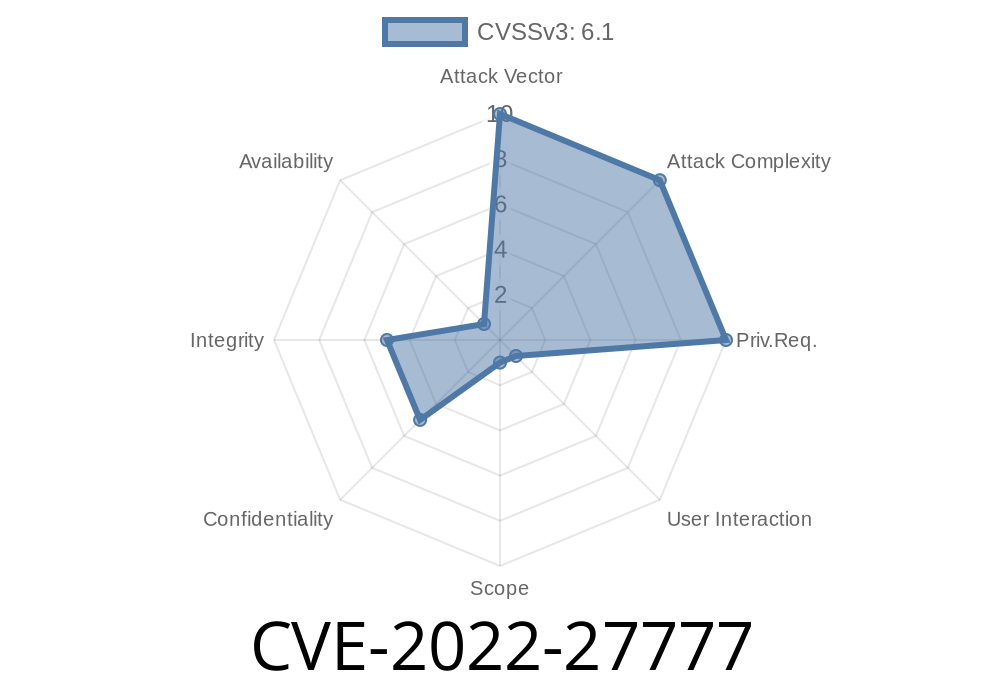Cross-site scripting (XSS) vulnerabilities remain one of the most common security flaws found in web applications today. The recently discovered CVE-2022-27777 affects Action View, a component of the popular Ruby on Rails framework. This XSS vulnerability specifically targets tag helpers in versions >= 5.2. and < 5.2. and allows an attacker to inject malicious content by controlling input into specific attributes.
In this post, we will delve into the details of the vulnerability, its potential impact, and how to prevent its exploitation. We will also include code snippets and references to help further your understanding of this security issue.
Vulnerability Details
The vulnerability (CVE-2022-27777) exists in the Action View's tag helpers, which are used to generate HTML tags and their attributes. An attacker could exploit this vulnerability by injecting malicious content into specific attributes, effectively causing an XSS attack. This could lead to a range of consequences, from stealing user data to compromising the entire web application.
Suppose we have the following code snippet
<%= tag.div class: user_input %>
An attacker could provide malicious input, such as
"foo\" onmouseover=\"alert('XSS')\" a=\""
This would generate the following HTML output
<div class="foo" onmouseover="alert('XSS')" a=""></div>
When rendered, the attacker's payload would be executed, causing the alert to be displayed.
Exploit Scenarios
1. Stealing sensitive user data: An attacker could craft a malicious script to extract confidential information from user input fields, such as login credentials or personal data.
2. Defacing the website: XSS vulnerabilities can provide attackers with the ability to modify website content, potentially harming the site's reputation.
3. Spreading malware: An attacker could use malicious scripts to deliver malware to unsuspecting users, turning the vulnerable website into a distribution platform.
4. Gaining unauthorized access: Depending on the web application's configuration, an XSS attack may grant an attacker elevated privileges by exploiting other vulnerabilities in the system.
Mitigation Strategies
To prevent the exploitation of this vulnerability, it is recommended to update the affected software components:
For Rails >= 6.1. and < 6.1.3.2, upgrade to Rails 6.1.3.2
At the same time, developers should follow secure coding practices to minimize the risk of XSS vulnerabilities:
1. Proper input validation: Always sanitize and validate user input to ensure only acceptable data is processed. Use built-in Ruby on Rails functions like sanitize or html_safe to achieve this.
2. Use output encoding: Make sure to encode user-generated content to prevent the accidental rendering of dangerous HTML tags or attributes.
3. Use a Content Security Policy (CSP): Implement a strong CSP to restrict vulnerable resources from executing unsafe inline scripts or loading external content.
4. Regularly audit your codebase: Regularly review your codebase for potential vulnerabilities and update any outdated dependencies.
Original References
1. National Vulnerability Database (NVD): CVE-2022-27777 details
2. Ruby on Rails Security Advisory: XSS vulnerability in Action View
Conclusion
XSS vulnerabilities continue to pose a significant threat to web applications, and CVE-2022-27777 in Action View's tag helpers is no exception. By understanding the exploit details and taking appropriate mitigation steps, developers can safeguard their applications and users against potential attacks. Regularly monitoring for and addressing new vulnerabilities remains a critical component of application security.
Timeline
Published on: 05/26/2022 17:15:00 UTC
Last modified on: 06/07/2022 14:35:00 UTC
